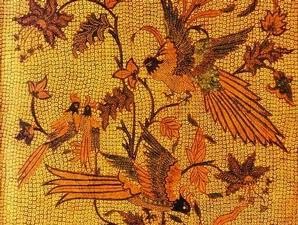Bali batik has always been one of the most highly regarded decorative fabrics because of the richness and detail in the batik motifs and colors. Predominantly originating from Bali, Java and others areas in Indonesia, the batik fabrics are an Indonesian traditional cloth also known as batik Jawa. Most of batik is still usually made by Balinese or Indonesian families in small, privately owned, factories or workshops here.
To make the batik fabrics takes a great deal time and have patience, particularly as many of the designs are often very intricate and complicated. There are three basic kinds of batik methods used in Bali and Indonesia: drawing wax batik, where patterns to be dyed into the cloth are drawn with a canting, a wooden 'pen' fitted with a reservoir for the hot, molten wax to run through. An alternative method is to hand print the fabric by using a handcrafted printing tool to carry the hot wax. There is also a combination technique, which uses elements of both methods to achieve some of the more elaborate batik designs.
Gods and religious stories inspire these beautiful designs or tales of everyday encounters being depicted in the various intricate patterns. Batik designs also have their own prestige or class distinction in Bali. The high-quality batik fabrics are usually worn to show your social status or standing in society. This of course is very similar to wearing designer labels or brands to show your wealth in the modern western world.
The method of drawing patterns in wax on fine woven cotton has been practiced as a form of meditation in Bali and Central Java now for many centuries. Originally this mediation was only performed by the by the female courtiers of the kingdoms and therefore it is still traditional for the Batik Tulis to be made only by women. The word 'Tulis" means to write, or is written, in the Indonesian language and many of the patterns do actually still incorporate letters from their alphabets.
The Indonesian word "batik" is translated literally as "good points or dots." Batik designs are made by creating tiny dots of hot wax to resist the dyes then applied on to the cloth. The most common fabrics used are fine cottons but also linens and silk, which make for very comfortable clothes and garments for hot climates.
Batik is said to bring the wearer good luck or placate in a difficult situation. In Indonesia it seems to date back to the early 16th century, although it also appears that some similar textile decorating methods may have been used long before that in Egypt or possibly earlier civilizations. The word Batik also refers to the textile presses as well as the resultant printed cloth, some of the more recognizable traditional fabrics are because of starting with a base cloth of brown, cream or indigo and developing the pattern colors from there.
Traditionally Indonesian batik has, and still is, in some regions created by using tree resin, insect wax, coconut oil, paraffin or sometimes recycled waxes, whichever is more readily available to the local community. After dying and drying the fabrics, the last step of the process is to remove the wax using boiling hot water and caustic soda. Once this has been done it brings out the fine lacy lines where the wax has cracked and some of they dyes have seeped in to form the unique qualities of the batik cloth. After this thorough treatment dyes used tend to be very color-fast and long lasting.
The Batik of Bali provides another great opportunity to show the artistic excellence of the Balinese people and their crafts. Their beautiful designs are inspired by religious mythology spread throughout the world. Originally the Balinese motifs were dominated by mythological characters handed down from generation to generation, but now contemporary batik artists have similar experience and artistic training that parallels that of many contemporary artists or painters.
Modern batik artists now express themselves through all kinds of subjects, from natural objects such as, trees, flowers, butterflies, birds or fish to daily activities and influences as well as their festival processions or religious ceremonies and mythological stories, But always with a flair of their own modern interpretation.






